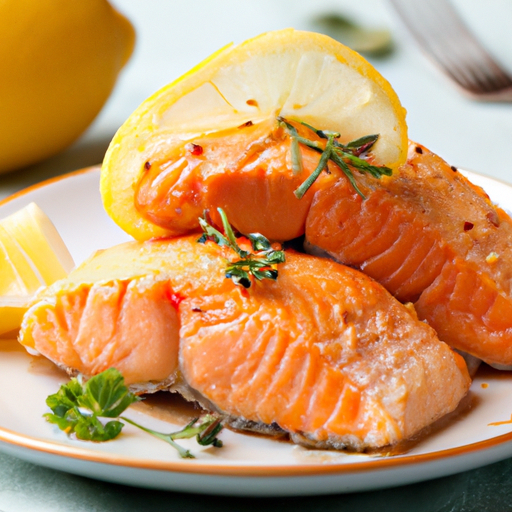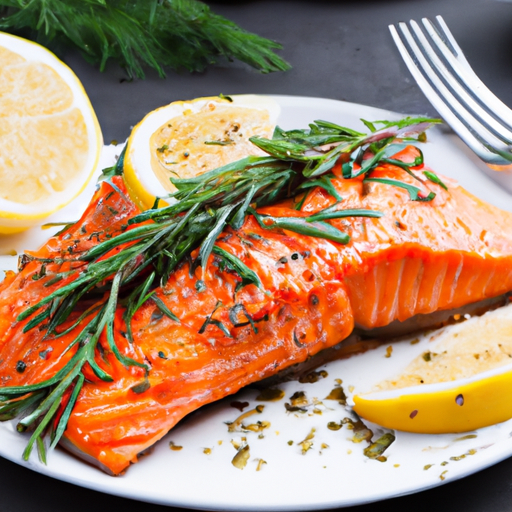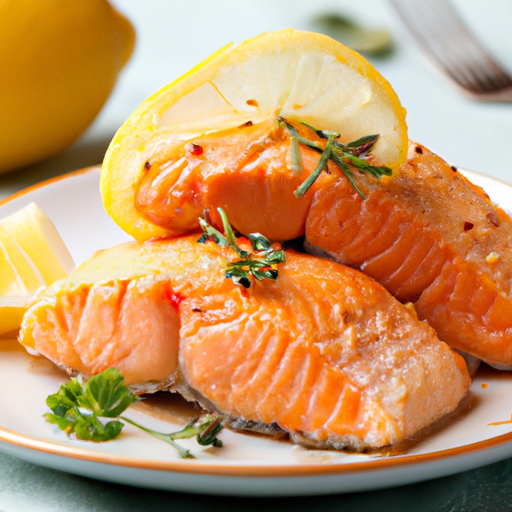If you’ve ever wanted to cook salmon but were unsure about the perfect cooking time, then we have just the solution for you. Introducing the “Easy Salmon Recipe with Perfect Cooking Time”! With this handy recipe, you’ll never have to worry about overcooking or undercooking your salmon again. Whether you prefer it rare, medium, or well-done, this recipe will guide you step-by-step to achieve the ideal cooking time for juicy and flavorful salmon every time. Say goodbye to guesswork and hello to deliciously cooked salmon with the help of this foolproof recipe.
Preparation
Preparing salmon for cooking involves a few simple steps to ensure a delicious and well-seasoned dish. Follow these instructions to get your salmon ready for the oven, grill, or pan.

Choose Fresh Salmon
When it comes to cooking salmon, the quality of the fish is crucial. Look for fresh salmon fillets at your local grocery store or fish market. The flesh should be firm, shiny, and free from any unpleasant odor. If possible, opt for wild-caught salmon for the best flavor.
Clean and Season
Before cooking, rinse the salmon fillets under cold water to remove any excess scales or debris. Pat them dry with a paper towel. This step helps create a better texture and allows the seasonings to adhere to the fish more effectively.
Next, season the salmon to enhance its natural flavors. You can keep it simple with just salt and pepper, or get creative with a variety of herbs and spices. Be sure to season both sides of the fillets evenly.
Preheat the Oven
If you’re planning to bake your salmon, preheating the oven is an essential step to ensure even cooking. Set your oven to the recommended temperature stated in your recipe. Preheating allows the salmon to cook more consistently and reduces the risk of it becoming overcooked.
Cooking Techniques
There are various cooking techniques that you can use to prepare salmon, each bringing out unique flavors and textures. Whether you prefer baking, grilling, or pan-searing, we’ve got you covered with simple instructions for each method.
Baking
Baking is a popular and foolproof way to cook salmon. This method provides a gentle and even heat, resulting in moist and tender fish.
Grilling
Grilling salmon adds a smoky and charred flavor that many people love. It’s a fantastic option for outdoor gatherings or when you want to infuse your dish with that unmistakable grill marks.
Pan-Searing
Pan-searing salmon creates a crispy crust on the outside while keeping the flesh juicy and flaky on the inside. It’s a quick and easy method that yields delicious results.
Baking Salmon
Baking is a versatile cooking technique that allows the salmon to cook gently and retain its moisture. Here’s a step-by-step guide to baking salmon to perfection.
Ingredients
- Fresh salmon fillets
- Salt and pepper to taste
- Olive oil or melted butter
- Lemon slices (optional, for garnish)
- Fresh herbs (optional, for additional flavor)
Steps for Baking
- Preheat your oven to the specified temperature in your recipe, usually around 375°F (190°C).
- Place the seasoned salmon fillets on a baking sheet lined with parchment paper or aluminum foil. Leave enough space between the fillets for even cooking.
- Drizzle some olive oil or melted butter over the salmon to keep it moist during the baking process.
- If desired, add lemon slices or fresh herbs on top of the fillets for extra flavor.
- Bake the salmon in the preheated oven for approximately 12-15 minutes. The cooking time may vary depending on the thickness of the fillets. The salmon is cooked when it reaches an internal temperature of 145°F (63°C) or until it flakes easily with a fork.
- Once cooked, remove the salmon from the oven and let it rest for a few minutes before serving. This resting time allows the juices to redistribute, resulting in a moist and flavorful dish.
Perfect Cooking Time
The cooking time for baked salmon can vary depending on the thickness of the fillets. As a general guideline, bake salmon for about 12-15 minutes at 375°F (190°C) or until it reaches an internal temperature of 145°F (63°C). Keep an eye on the salmon to avoid overcooking, as it can quickly become dry.
Grilling Salmon
Grilling salmon imparts a delicious smoky flavor and creates beautiful grill marks on the fish. Follow these steps to achieve perfectly grilled salmon every time.
Ingredients
- Fresh salmon fillets
- Salt and pepper to taste
- Olive oil or melted butter
- Lemon wedges (optional, for serving)
- Fresh herbs (optional, for garnish)
Steps for Grilling
- Preheat your grill to medium heat. Make sure the grates are clean and well-oiled to prevent the salmon from sticking.
- Season the salmon fillets with salt and pepper on both sides. Lightly coat them with olive oil or melted butter to prevent them from drying out during grilling.
- Place the seasoned salmon fillets onto the preheated grill, skin-side down. Close the lid and cook for about 4-6 minutes.
- Carefully flip the fillets using a spatula or grill tongs to cook the other side. Cook for an additional 4-6 minutes, or until the salmon reaches an internal temperature of 145°F (63°C). The cooking time can vary depending on the thickness of the fillets, so keep a close eye on them to prevent overcooking.
- Once grilled to perfection, remove the salmon from the grill, and let it rest for a few minutes before serving.
- Serve your delicious grilled salmon with lemon wedges and fresh herbs for added brightness and flavor.
Perfect Cooking Time
Grilling salmon generally takes around 4-6 minutes per side, depending on the thickness of the fillets. The internal temperature should reach 145°F (63°C) for a perfectly cooked and juicy salmon. Be mindful not to leave the salmon on the grill for too long, as it can easily dry out.
Pan-Searing Salmon
Pan-searing salmon is a quick and straightforward method that results in a delightful combination of juicy flesh and crispy skin. Follow these steps for a delicious pan-seared salmon dish.
Ingredients
- Fresh salmon fillets
- Salt and pepper to taste
- Olive oil or butter
- Lemon wedges (optional, for serving)
- Fresh herbs (optional, for garnish)
Steps for Pan-Searing
- Heat a skillet, preferably a non-stick or cast-iron, over medium-high heat. Add enough olive oil or butter to coat the bottom of the skillet.
- Season the salmon fillets with salt and pepper on both sides.
- Carefully place the fillets, skin-side down, into the hot skillet. Press them gently to ensure even contact with the skillet.
- Allow the salmon to cook undisturbed for about 4-5 minutes, or until the skin turns crispy and releases easily from the pan. This helps create that delightful crust.
- Flip the salmon fillets using a spatula. Cook for an additional 3-4 minutes, or until the internal temperature reaches 145°F (63°C). The flesh should be opaque and flake easily with a fork.
- Remove the pan-seared salmon from the skillet and let it rest for a few minutes to ensure maximum juiciness.
- Serve the pan-seared salmon with lemon wedges and fresh herbs for a burst of flavor.

Perfect Cooking Time
Pan-searing salmon typically takes about 4-5 minutes per side, depending on the thickness of the fillets. The internal temperature should reach 145°F (63°C) for perfectly cooked fish that is moist and tender. Be mindful not to overcook the salmon, as it can become dry and lose its delicate texture.
Marinating Options
Marinating salmon is a fantastic way to infuse it with additional flavors and tenderize the fish. Here are three delicious marinating options to take your salmon to another level.
Citrus-Marinated Salmon
Citrus marinades add a refreshing and tangy twist to salmon. Combine the juice of your favorite citrus fruits, such as lemon, lime, and orange, with olive oil, garlic, and a pinch of salt. Let the salmon marinate in this mixture for at least 30 minutes before cooking to allow the flavors to penetrate the fish.
Garlic and Herbs Marinade
Garlic and herbs are a classic combination that elevates salmon to new heights. Create a marinade with minced garlic, chopped fresh herbs like rosemary, thyme, and dill, olive oil, salt, and pepper. Allow the salmon to marinate for at least 1 hour, or overnight for a more intense flavor.
Teriyaki Marinated Salmon
Teriyaki marinade adds a sweet and savory note to salmon. Prepare a marinade using soy sauce, honey or brown sugar, minced ginger, garlic, and a splash of rice vinegar. Let the salmon marinate for at least 1 hour, ensuring the fillets are well-coated in the delicious teriyaki mixture.
Serving Suggestions
Now that you have perfectly cooked salmon, it’s time to think about how to present and enhance the flavors even further. Here are some serving suggestions to create a well-rounded and delicious meal.
Accompaniments
Pair your salmon with a selection of accompaniments that complement its flavors. Some popular choices include creamy mashed potatoes, steamed rice, or couscous. You can also serve it with roasted vegetables, such as asparagus, Brussels sprouts, or zucchini, for a complete and nutritious meal.
Garnishes
Garnishes not only add visual appeal but also provide an extra burst of flavor. Sprinkle some freshly chopped herbs, such as parsley or dill, over the salmon to brighten up the dish. Thinly sliced lemon wheels or wedges are also a great garnish that adds a refreshing and tangy touch.
Side Dish Ideas
If you’re looking for side dish ideas to accompany your salmon, consider options that complement the flavors and textures of the fish. A light and refreshing spinach salad with a citrus-based vinaigrette pairs well with salmon. Alternatively, you can prepare a side of sautéed mushrooms or a creamy, herb-infused risotto for an indulgent twist.
Tips and Tricks
To ensure your salmon turns out perfectly every time, here are some handy tips and tricks to keep in mind.
Check for Doneness
To check if your salmon is cooked to perfection, insert a sharp knife into the thickest part of the fillet and gently pry it open. The flesh should be opaque and flake easily. Alternatively, you can use a meat thermometer to ensure the internal temperature reaches 145°F (63°C) for optimal doneness.
Resting Time
After cooking, allow your salmon to rest for a few minutes before serving. This short resting period allows the juices to redistribute throughout the fish, resulting in a more flavorful and moist final dish. Simply cover the cooked salmon loosely with foil during the resting period.
Storing and Reheating
If you have any leftovers, store them in an airtight container in the refrigerator for up to 2-3 days. To reheat the salmon, gently warm it in a skillet over low heat or in the oven at a low temperature to avoid drying it out.
Common Mistakes to Avoid
When cooking salmon, it’s important to be aware of common mistakes that can sabotage the final result. Here’s what to avoid:
Overcooking
One of the most common mistakes is overcooking salmon. Overcooked salmon can become dry and lose its delicate texture. To avoid this, be mindful of the cooking time and check for doneness using a knife or meat thermometer.
Underseasoning
Salmon has a mild flavor, and underseasoning can result in a dull and lackluster dish. Make sure to season the fish with salt, pepper, and additional herbs or spices to enhance its natural flavors.
Using Frozen Salmon
While frozen salmon can be a convenient option, it’s important to thaw it properly before cooking. Thaw the salmon in the refrigerator overnight or under cold running water. Cooking frozen salmon directly can result in uneven cooking and a less enjoyable texture.
Conclusion
Cooking salmon is a delightful experience that allows you to savor the flavors of this versatile fish. Whether you choose to bake, grill, or pan-sear your salmon, remember to select fresh fillets, season them well, and cook them with care. With the right techniques and a few additional touches, you can create a mouthwatering salmon dish that will impress your family and friends. Enjoy the journey of cooking salmon and savor the delicious results!
